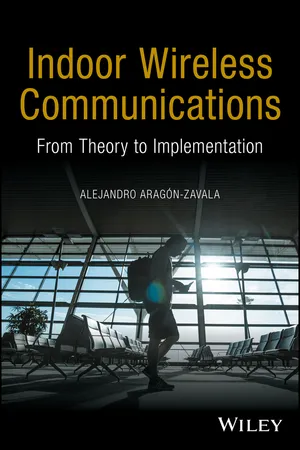
- English
- ePUB (mobile friendly)
- Available on iOS & Android
About This Book
Indoor Wireless Communications: From Theory to Implementation provides an in-depth reference for design engineers, system planners and post graduate students interested in the vastly popular field of indoor wireless communications. It contains wireless applications and services for in-building scenarios and knowledge of key elements in the design and implementation of these systems. Technologies such as Wireless Local Area Networks, Bluetooth, ZigBee, Indoor Optical Communications, WiMAX, UMTS and GSM for indoor environments are fully explained and illustrated with examples. Antennas and propagation issues for in-building scenarios are also discussed, emphasizing models and antenna types specifically developed for indoor communications. An exhaustive survey on indoor wireless communication equipment is also presented, covering all available technologies including antennas, distribution systems, transceivers and base stations.
Frequently asked questions
Information
1
Introduction
1.1 Motivation
- The increased volume of mobile data use puts a greater load on macrocell capacity to deliver a reliable service.
- User expectations of the minimum data rate that constitutes a viable service are continuing to increase and are dominated by the indoor locations in which they mostly consume services.
- Modern mobile devices have to support a wide range of frequency bands in a small-form factor, reducing their sensitivity and hence increasing the signal strength needed to achieve a given coverage.
- Improved thermal insulation properties of buildings lead to an increase in the use of denser and more conductive external construction materials, including metallized windows, increasing the losses that radio waves encounter in penetrating a building.
- Increased use of high-frequency bands at 2.1 GHz, 2.4 GHz, 2.6 GHz, 3.5 GHz and beyond, which suffer greater losses than frequencies below 1 GHz.
- Economic incentives for mobile operators to share macrocell networks, reducing the diversity of options for users to switch to operators who do have macrocell coverage close to the locations they care most about.
- In the UK, Wi-Fi is the main Internet connection for smartphones at nearly 60%.
- The desire for faster, more reliable connectivity is the principal driver of Wi-Fi usage over cellular mobile.
- Almost 90% of both smartphone and tablet users connect to the Internet using Wi-Fi from home.
- The types of indoor wireless technologies and their characteristics
- Design requirements and standards for coverage and capacity
- Voice and data traffic considerations when deploying an indoor radio solution
- The physics of in-building radio propagation
- Channel modelling options that are available to estimate coverage in an indoor radio system
- Available RF and antenna equipment for indoor systems
- Measurement techniques and systems used to design and validate in-building networks
- Practical issues related to indoor radio design and deployment that could be useful for engineers, students and scientists.
1.2 Evolution of Macro to Heterogeneous Networks
- Future demand for spectrum. The indoor layer of the network starts to soak up the rapid increase in demand and the value of future mobile spectrum allocations may be reduced.
- Interference management. Current policy stipulates that coordination between multioperators should be resolved by each party. A market-driven change into the network architecture may impact the regulatory policy in this area.
- Competition between MNOs. Competition may start to be reduced by the growing use of multioperator collaborations on both the core network and on the Radio Access Network.
- Incentives for investment. There may come a time when operators reduce their level of investment in the macronetwork to focus on serving the indoor consumers with smaller more cost effective building solutions.
- Consumer switching. This is encouraged by operators marketing their new products and services.
- Wide area coverage
- Targeting mobile voice
- Roads/carphones.
- Usage is predominantly indoors (70–90% of the traffic by volume) (Analysis Mason Ltd, 2011).
- The indoor locations of relevance are predominantly just two per person (my home, my office), that is not just geographical coverage.
- Indoor coverage is often cited by operators as the number one network-related cause of churn.
- Smartphones have poorer sensitivity than traditional phones – and it gets worse as more bands are added.
- Even voice is increasingly on 3G and LTE: better link budget, but mainly 2.1 GHz today.
- User expectation of what constitutes the minimum acceptable data rate increases with time (as does expectation of typical rates).
- Building regulations increasingly specify thermal insulation requirements, which are increasingly being met by metallized glass, significantly increasing attenuation.
1.3 Challenges
- One solution can simultaneously handle users with different operators.
- Solutions are cheap, unobtrusive and simple enough to permit multiples of them in one location if needed.
- It could work for any operator and can be changed between operators at the user's choice (but only phones from one operator at a time).
- It is easy and cheap to switch operators even if one ‘box’ cannot handle multiple operators.
- Allow consumers to take action themselves rather than ‘begging’ an operator; for example, three currently limit femtocells to those who they consider have a valid coverage problem.
- How does this compare and contrast with being able to move your phone between providers, move contracts between providers or move gateways/home hubs between providers.
Table of contents
- Cover
- Title Page
- Copyright
- Dedication
- Preface
- Chapter 1: Introduction
- Chapter 2: Indoor Wireless Technologies
- Chapter 3: System Requirements
- Chapter 4: Radio Propagation
- Chapter 5: Channel Modelling
- Chapter 6: Antennas
- Chapter 7: Radio Measurements
- Chapter 8: Capacity Planning and Dimensioning
- Chapter 9: RF Equipment and Distribution Systems
- Chapter 10: Small Cells
- Chapter 11: In-Building Case Studies
- Index
- End User License Agreement